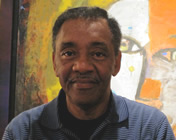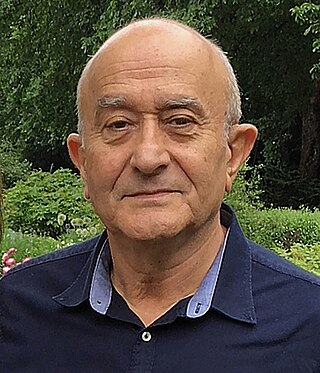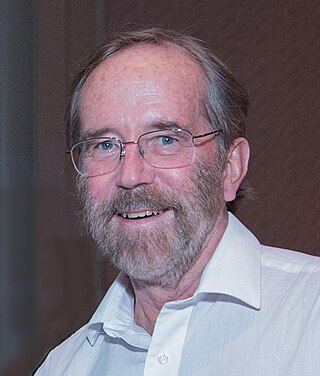
Aage Niels Bohr was a Danish nuclear physicist who shared the Nobel Prize in Physics in 1975 with Ben Roy Mottelson and James Rainwater "for the discovery of the connection between collective motion and particle motion in atomic nuclei and the development of the theory of the structure of the atomic nucleus based on this connection". His father was Niels Bohr.
Optica, founded as the Optical Society of America, is a professional society of individuals and companies with an interest in optics and photonics. It publishes journals, organizes conferences and exhibitions, and carries out charitable activities.

Eli Yablonovitch is an American physicist and engineer who, along with Sajeev John, founded the field of photonic crystals in 1987. He and his team were the first to create a 3-dimensional structure that exhibited a full photonic bandgap, which has been named Yablonovite. In addition to pioneering photonic crystals, he was the first to recognize that a strained quantum-well laser has a significantly reduced threshold current compared to its unstrained counterpart. This is now employed in the majority of semiconductor lasers fabricated throughout the world. His seminal paper reporting inhibited spontaneous emission in photonic crystals is among the most highly cited papers in physics and engineering.

Lewi Tonks was an American physicist who worked for General Electric on microwaves, plasma physics and nuclear reactors. Under Irving Langmuir, his work pioneered the study of plasma oscillations. He is also noted for the noted for his discovery of the Tonks–Girardeau gas.

The American Institute of Physics (AIP) promotes science and the profession of physics, publishes physics journals, and produces publications for scientific and engineering societies. The AIP is made up of various member societies. Its corporate headquarters are at the American Center for Physics in College Park, Maryland, but the institute also has offices in Melville, New York, and Beijing.
SPIE is an international not-for-profit professional society for optics and photonics technology, founded in 1955. It organizes technical conferences, trade exhibitions, and continuing education programs for researchers and developers in the light-based fields of physics, including: optics, photonics, and imaging engineering. The society publishes peer-reviewed scientific journals, conference proceedings, monographs, tutorial texts, field guides, and reference volumes in print and online. SPIE is especially well-known for Photonics West, one of the laser and photonics industry's largest combined conferences and tradeshows which is held annually in San Francisco. SPIE also participates as partners in leading educational initiatives, and in 2020, for example, provided more than $5.8 million in support of optics education and outreach programs around the world.

Physics Today is the membership magazine of the American Institute of Physics. First published in May 1948, it is issued on a monthly schedule, and is provided to the members of ten physics societies, including the American Physical Society. It is also available to non-members as a paid annual subscription.
The Medard W. Welch Award is given to scientists who demonstrated outstanding research in the fields pertinent to the focus areas of the American Vacuum Society, which are "the basic science, technology development, and commercialization of materials, interfaces, and processing." It was established in 1969 in memory of Medard W. Welch, a founder of the American Vacuum Society.

Jens Kehlet Nørskov is the Villum Kann Rasmussen professor at the Technical University of Denmark. He is a Danish physicist most notable for his work on theoretical description of surfaces, catalysis, materials, nanostructures, and biomolecules.

John M. "Jack" Carpenter was an American nuclear engineer known as the originator of the technique for utilizing accelerator-induced intense pulses of neutrons for research and developing the first spallation slow neutron source based on a proton synchrotron, the Intense Pulsed Neutron Source (IPNS). He died on 10 March 2020.
Richard Magee Osgood Jr. was an American applied and pure physicist. He was Higgins Professor of Electrical Engineering and Applied Physics at Columbia University.

Milton Dean Slaughter is an American theoretical and phenomenological physicist and affiliate professor of physics at Florida International University. Slaughter was a visiting associate professor of physics in the Center for Theoretical Physics, University of Maryland, College Park while on sabbatical from Los Alamos National Laboratory (LANL) of the University of California from 1984 to 1985. He is also chair emeritus and university research professor of physics emeritus at the University of New Orleans (UNO). Prior to joining UNO as chair of the physics department: He was a postdoctoral fellow in the LANL Theoretical Division Elementary Particles and Field Theory Group (T-8); LANL Theoretical Division Detonation Theory and Applications Group (T-14) staff physicist; LANL Theoretical Division affirmative action representative and staff physicist; LANL assistant theoretical division leader for administration and staff physicist (T-DO); LANL Nuclear and Particle Physics Group staff physicist—Medium Energy Physics Division (MP-4); and LANL Historically Black Colleges and Universities (HBCU) project manager (laboratory-wide).

Ivan Georgiev Petrov is a Bulgarian-American physicist specializing in thin films, surface science, and methods of characterization of materials. His research and scientific contributions have been described as having an "enormous impact on the hard-coatings community". Petrov was the president of the American Vacuum Society for 2015.
The International Union for Vacuum Science, Technique, and Applications (IUVSTA) is a union of 35 science and technology national member societies that supports collaboration in vacuum science, technique and applications.
Dorothy M. Hoffman was an American chemical engineer. In 1974 she became the first woman to be elected president of American Vacuum Society and the first woman to serve as president of any scientific society in the USA.

Joseph "Joe" E. Greene, known in his professional writing as J. E. Greene was an American materials scientist, specializing in thin films, crystal growth, surface science, and advanced surface engineering. His research and scientific contributions in these areas have been described as "pioneering" and "seminal" and that his work "revolutionized the hard-coating industry".
Marjorie Ann Olmstead is an American condensed matter physicist.
Sally L. McArthur is an Australian materials scientist who is a professor of biomedical engineering at Swinburne University of Technology and a research scientist at CSIRO. Her research considers the development of novel biomaterials for biomedical, nutritional and environmental applications.
Michael Duryea Williams is an American physicist, professor at Clark Atlanta University, and current president of the AVS: Science and Technology of Materials, Interfaces, and Processing. He is the first African American president of AVS.
Jane Pei-chen Chang is a Taiwanese-American chemical engineer and materials scientist known for her research developing advanced atomic layer deposition (ALD) and etching techniques. Her research focuses on creating thin films and coatings with precise properties for use in microelectronics, energy devices, and other advanced materials applications.









